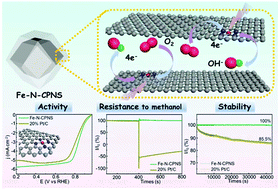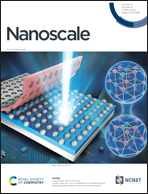Turning on electrocatalytic oxygen reduction by creating robust Fe–Nx species in hollow carbon frameworks via in situ growth of Fe doped ZIFs on g-C3N4†
Abstract
Iron–nitrogen–carbon (Fe–N–C) electrocatalysts have been demonstrated to be promising candidates to substitute conventional Pt/C electrocatalysts in the oxygen reduction reaction (ORR) due to the benefits of high efficiency and affordable price. Unfortunately, Fe is prone to aggregation upon high-temperature treatment, which may cover the active sites of the Fe–Nx species and further affect the ORR performance. Thus, the key issue is to avoid Fe aggregation and keep it uniformly dispersed as much as possible. In this work, Fe–N–C catalysts with robust Fe–Nx species in hollow carbon frameworks were created via in situ growth of Fe doped Zn based zeolitic imidazolate frameworks (ZIFs) on g-C3N4 with the subsequent pyrolysis treatment. The developed catalysts demonstrate superb ORR activity, high resistance to methanol and ultralong stability as compared with traditional Pt/C catalysts in alkaline solution. The brilliant performance benefits from the firm connection and robust structure of the optimal Fe–Nx species that are homogeneously dispersed in the hollow carbon frameworks. This work presents a facile and reasonable strategy for the development of excellent ORR electrocatalysts.



 Please wait while we load your content...
Please wait while we load your content...